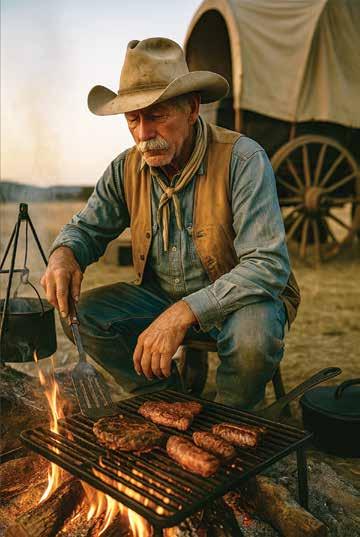
4 minute read
From Trail Smoke to Strip Malls
by Charlotte Kovalchuk
Serving Up Texas Barbecue History
Texas barbecue isn’t just a beloved cuisine—it’s heritage wrapped in butcher paper and passed down through generations of fire, flavor, and tradition. Born from the fire pits of cattle drives, shaped in the smokehouses of European immigrants, and perfected in the roadside pits of African American communities, barbecue is a tradition as diverse as Texas itself. Today, that storied legacy shows up everywhere–from Lockhart town squares to suburban strip malls–each bite telling a story of grit, migration, and cultural fusion.
Ancient Origins: Indigenous and Spanish Influences
Long before European settlers arrived, Native American tribes like the Caddo were roasting venison and other game over open fires and in earth ovens, laying the groundwork for Texas’ slow-cooked meat traditions.
In the 1600s, Spanish shepherds on the plains of South Texas introduced al pastor–spit-roasted lamb and goat–borrowing from Caribbean and Moorish traditions. Their methods, blending spices and smoke over open flames, further enriched the region’s culinary landscape.
According to the Texas Historical Commission, it wasn’t until the early 1800s that the word “barbecue” likely entered the Texas lexicon. The term was a variation of the Haitian word barbacot–a framework of sticks used for smoking or roasting meat. It made its way to Texas via enslaved Haitians in the Carolinas who had introduced the method of barbecuing to Southern plantation owners. From there, the word and the technique traveled west, embedding themselves in the state’s food culture.
19th Century: The Birth of Barbecue Culture
After the Civil War, Texas became the epicenter of the American cattle industry. Trails like the Chisholm and Goodnight-Loving enabled Texas to evolve as the heart of America’s beef belt. Cowboys who worked long hours in harsh conditions cooked salvaged cuts of meat over open fires using green mesquite or oak wood. This was
survival cooking–practical, rustic, and rich in smoke. These early chuck wagon pit stops laid the foundation for the smoky techniques that would become hallmarks of Texas barbecue.
Meanwhile, German and Czech immigrants in Central Texas brought Old World butchery and meat preservation techniques to the region. In towns like Elgin, Taylor, and Lockhart, they opened meat markets that smoked sausages and briskets in brick or cinder block pits. The food was simple but satisfying–slices of pepper-crusted brisket or rings of pork sausage, served with saltines, pickles, and onions. No sauce. No frills. Just smoke, salt, and craftsmanship–a tradition that continues today at historic joints like Kreuz Market and Southside Market.
Late 19th to Early 20th Century: African American Traditions Take Root
Barbecue culture in East Texas flourished in African American communities, where pit masters transformed smoke and sauce into entrepreneurial lifelines during the era of Jim Crow segregation. With limited access to capital or storefronts, many began selling ribs and links out of backyard pits or roadside stands, often near churches or in makeshift sheds along dirt roads. The style became distinct: meats slow-cooked until falling apart, slathered in rich, sweet, tomato-based sauces, and served with white bread, beans, and soulful hospitality.
20th Century: Barbecue Becomes a Community Staple
As Texas towns expanded in the 20th century, barbecue grew into a civic ritual. What had once been trail fare evolved into a fixture at community gatherings, political rallies, Juneteenth celebrations, Sunday fundraisers, and family reunions. In Central Texas, meat markets like Louie Mueller Barbecue in Taylor or Kreuz Market in Lockhart doubled as communal space–places where neighbors caught up over sausage links and butcher paper-stained picnic tables. In African American communities, barbecue fundraisers helped sustain churches and schools underfunded by segregation-era policies.
By the 1960s and ‘70s, as highways expanded and towns suburbanized, barbecue joints began popping up in shopping centers and roadside stops. These unassuming spots–often little more than converted gas stations or cinder block shacks–became neighborhood institutions, preserving family recipes and feeding generations with a steady fire and an open door.
Modern Era: The Craft Barbecue Renaissance
In the last 20 years, Texas has witnessed a full-blown barbecue revival. Pit masters like Aaron Franklin of Austin’s Franklin Barbecue have brought national acclaim to the state’s traditions, elevating brisket to cult status and drawing lines that snake around city blocks. But this renaissance didn’t replace the old ways–it amplified them. Today’s pit masters often honor the traditions that came before, with the saucy tenderness of East Texas, the salt-and-smoke purity of Central Texas, or the border-blending flavors of the Rio Grande Valley. The heart of Texas barbecue still beats strong in the pits of small towns, roadside joints, and backyard smokers.








